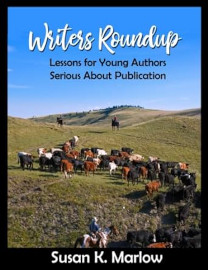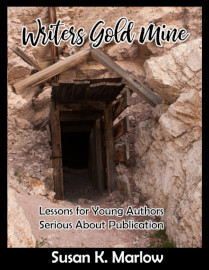Writers Gold Mine and Writers Roundup both carry the subtitle Lessons for Young Authors Serious About Publication. Both books are for ages 11 and up, with Writers Gold Mine written for boys and Writers Roundup for girls. The books occasionally use examples featuring female or male characters in situations that either girls or boys are most likely to relate to, but you could use either book with both sexes if you prefer.
Both books cover the same lessons in the same order to teach students narrative writing, but they change slightly to reflect either the gold-mining theme or ranching theme as well as male and female examples. Author Susan K. Marlow uses characters from her Circle C and Goldtown adventure novels within the courses. While students will probably enjoy the courses more if they are already familiar with the characters, reading the novels is not required and doesn’t add to their effectiveness.
Writers Gold Mine and Writers Roundup, which I will call the writers workbooks through the rest of my review, teach the entire writing process from prewriting through publication. These 142-page books help students develop writing skills through the creation of a novel, teaching the five essential elements: characters, setting, story problem, plot events, and solution.
While the writers workbooks are recommended for students as young as 11, they need to have already mastered basic skills for writing sentences and paragraphs. Marlow’s goal is to have students write a publishable novel—quite a challenge for many students. Since the project demands a great deal of thinking, planning, and work, students need to be mature enough and motivated to work on the long-term project. These courses can serve as your primary English courses for a semester or more, and writing a novel might be a more appealing way to develop composition skills than standard courses.
Children who want to write a simple story should probably use a different course. These writers workbooks teach some sophisticated techniques, such as how to intermix dialogue with narrative to keep the story from sounding like back-and-forth chatter and how to write using first-, second-, or third-person points of view. Even aspiring adult writers should find these lessons appropriate.
 The 12 lessons in each writers workbook are developed through several activities per lesson. For example, the fifth lesson teaches about setting. The lesson begins with eight pages of instruction, drawing activities, and writing assignments to help students employ specific, descriptive words, “sounds,” and emotions that convey vivid settings. Then a one-page writing activity has them practice putting a character into a setting. Within this same lesson, Marlow also teaches about improving writing by varying the types of sentences and eliminating “dead words” and extraneous details. The number of activities per lesson means each will almost certainly be spread out over more than one session.
The 12 lessons in each writers workbook are developed through several activities per lesson. For example, the fifth lesson teaches about setting. The lesson begins with eight pages of instruction, drawing activities, and writing assignments to help students employ specific, descriptive words, “sounds,” and emotions that convey vivid settings. Then a one-page writing activity has them practice putting a character into a setting. Within this same lesson, Marlow also teaches about improving writing by varying the types of sentences and eliminating “dead words” and extraneous details. The number of activities per lesson means each will almost certainly be spread out over more than one session.
A key idea that Marlow emphasizes is showing rather than telling, and she includes lesson activities and tools to help students. For example, to make it easier for students to describe characters by “showing,” she provides a chart with words and phrases that help convey different emotions. Rather than just saying a character is frustrated, she suggests using “showing” words or phrases such as crossed arms, pouting, tapping foot, breathing fast, clenched fists, and outbursts (p. 35).
After covering the five elements of a story, the lessons have students write their rough draft, revise and edit their draft, write a final draft, and consider publishing options.
Students are provided with many models for each step, and they practice with material in the book before tackling the components of their own novels. For example, before writing the conclusion for their own novels, students are given five story endings from well-known books (e.g., The Last Battle by C.S. Lewis) to analyze. They study another student’s story ending, and they practice writing a satisfactory ending for a short story summarized in a nutshell for them. Each carefully designed step makes writing a novel surprisingly manageable for students. Nevertheless, producing an interestingly written, coherent story will require students to dedicate a serious amount of time to the project.
Since sharing or publishing students’ novels is the goal of the courses, publishing options include detailed instructions for laying out both the interior pages and the cover for a print-on-demand book.
Some activities have predictable answers, and answer keys are at the back of the writers workbooks. Other writing activities, especially the student-written novels, require subjective evaluation. Students are assisted in self-checking their work with a Rough Draft Checklist. There’s also a checklist regarding layout for those preparing for actual publication. At several points, students are directed to get feedback from a knowledgeable person on how successfully they have conveyed their ideas. So students cannot work entirely on their own.
Depending on the age and diligence of the student writer, and whether they decide to actually publish their book, you might take a semester or more to complete a course.
Free Video Lessons
Marlow has also created ten free, online video lessons (with edited material from Zoom classes she has presented) that correlate with both Writers Roundup and Writers Gold Mine. The videos run 15 to 22 minutes each and appear to have been created with generously illustrated PowerPoint slides accompanied by Marlow’s voiceover instruction. The videos walk students through the lessons in the writers workbooks, indicating which pages in the book correlate with each video lesson. Students complete some pages in the book during the video lessons, pausing the video to do so, and many pages will be completed after each video lesson.
Summary
Writers Roundup and Writers Gold Mine can be used in several ways. Most students, whatever their age, will benefit from working in a group class where they can share and get feedback, but that isn’t required. Older students might be able work independently, getting feedback when directed. The videos might be especially helpful for students who appreciate multisensory input and don’t have a group class available.
Whatever approach is used, both writers workbooks should help serious student writers successfully write a novel they will be proud to share with others.










